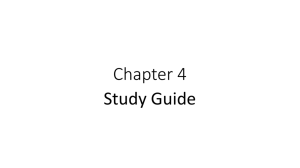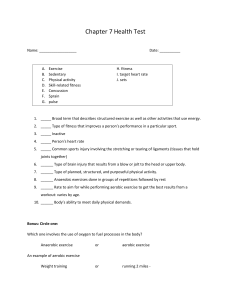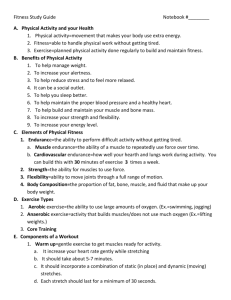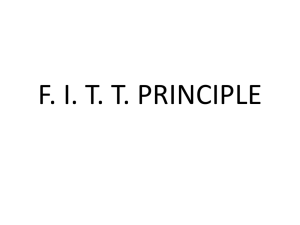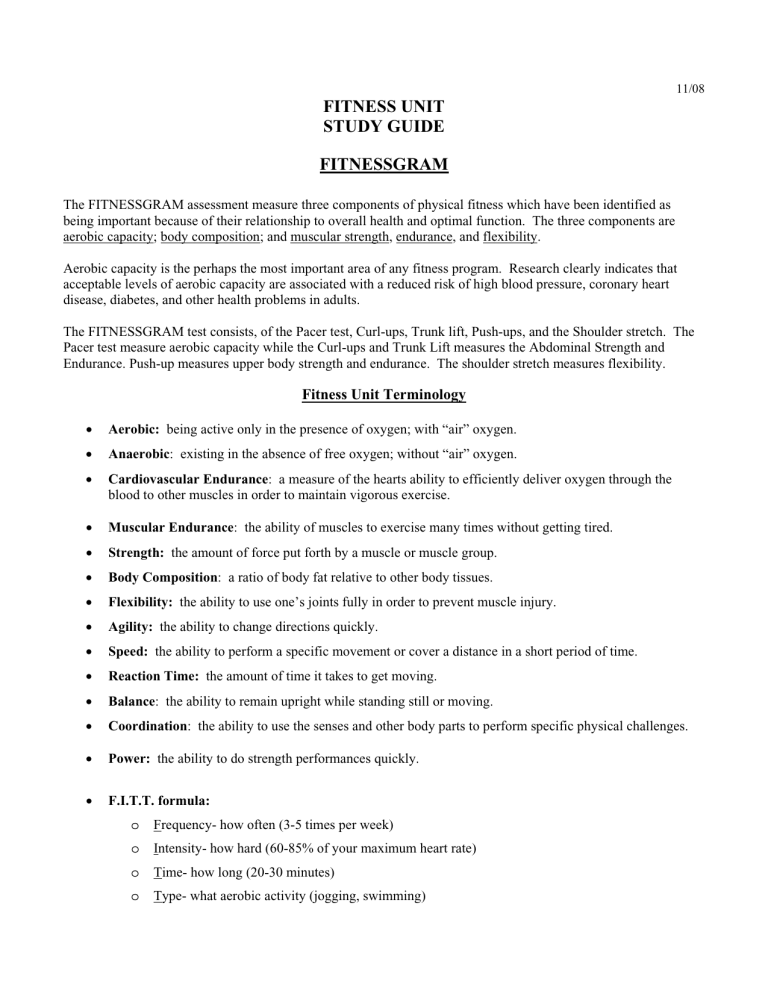
11/08 FITNESS UNIT STUDY GUIDE FITNESSGRAM The FITNESSGRAM assessment measure three components of physical fitness which have been identified as being important because of their relationship to overall health and optimal function. The three components are aerobic capacity; body composition; and muscular strength, endurance, and flexibility. Aerobic capacity is the perhaps the most important area of any fitness program. Research clearly indicates that acceptable levels of aerobic capacity are associated with a reduced risk of high blood pressure, coronary heart disease, diabetes, and other health problems in adults. The FITNESSGRAM test consists, of the Pacer test, Curl-ups, Trunk lift, Push-ups, and the Shoulder stretch. The Pacer test measure aerobic capacity while the Curl-ups and Trunk Lift measures the Abdominal Strength and Endurance. Push-up measures upper body strength and endurance. The shoulder stretch measures flexibility. Fitness Unit Terminology Aerobic: being active only in the presence of oxygen; with “air” oxygen. Anaerobic: existing in the absence of free oxygen; without “air” oxygen. Cardiovascular Endurance: a measure of the hearts ability to efficiently deliver oxygen through the blood to other muscles in order to maintain vigorous exercise. Muscular Endurance: the ability of muscles to exercise many times without getting tired. Strength: the amount of force put forth by a muscle or muscle group. Body Composition: a ratio of body fat relative to other body tissues. Flexibility: the ability to use one’s joints fully in order to prevent muscle injury. Agility: the ability to change directions quickly. Speed: the ability to perform a specific movement or cover a distance in a short period of time. Reaction Time: the amount of time it takes to get moving. Balance: the ability to remain upright while standing still or moving. Coordination: the ability to use the senses and other body parts to perform specific physical challenges. Power: the ability to do strength performances quickly. F.I.T.T. formula: o Frequency- how often (3-5 times per week) o Intensity- how hard (60-85% of your maximum heart rate) o Time- how long (20-30 minutes) o Type- what aerobic activity (jogging, swimming) Tae Bo/Cardio Kickboxing Tae Bo is a low-impact cardiovascular activity. It involves the continuous performance of the ancient art of selfdefense, dance and boxing. The following is a list of movements used during Tae Bo. Punches: Jab, Upper Cut, Cross, and Hook Kicks: Front, Back, Side and Roundhouse Elements of fitness used during Tae Bo include; strength, balance, flexibility and endurance. Increasing the speed and adding weights will add intensity to the workout. Fitness Room Game and Stationary Bike Guidelines Always check and adjust the bike seat before beginning to ride. Both feet must remain on the pedals while riding. Pedal in a forward directions. Never stand up while pedaling the bike. You must keep at least one hand held to the handlebar during your workout. To start your workout on the stationary bike you must press the Quick Start button while pedaling and press the + arrow to increase tendency to level 5 for your workout. Once you have completed your workout on any of the cardio-equipment you will need to record your training log, your distance, heart rate and time. Strength Training Guidelines Inspect equipment before each use. Fully insert the pine. Partial insertion of the pin may cause weight to fall unexpected. Never remove the pin if any weights are suspended. Before you begin to lift, you should adjust your seat and set your pin properly before lifting. Back, hips, and ankles should be at a 90 degree angle when lifting. Core Training Core exercises strengthen your core muscles which include your abdominals, spinal erectors, oblique’s, gluteus maximus/minimus, quadriceps, and hamstrings. Each muscle serves a certain function. The abdominals help you bend at the waist. Spinal erectors help you straighten. Obliques help you twist and bend at the side. Gluteals help you stand and sit. Quadriceps help you straighten knee or extend your leg and your hamstrings help you bend at your knee. Focus on tightening your abdominal muscle—rectus abdominis—during each exercise. This is the muscle you feel when you poke yourself in the stomach. You can work on your core using an exercise ball, medicine ball, or just your body weight. Another group of exercises that work your core are called Plyometrics. Plyometrics are a fancy name for jumping exercise.
